Recently I posted a single photo of this beautiful hawk. Some folks were so enthralled with the bird that they asked to see more so this morning I’m complying with that request.
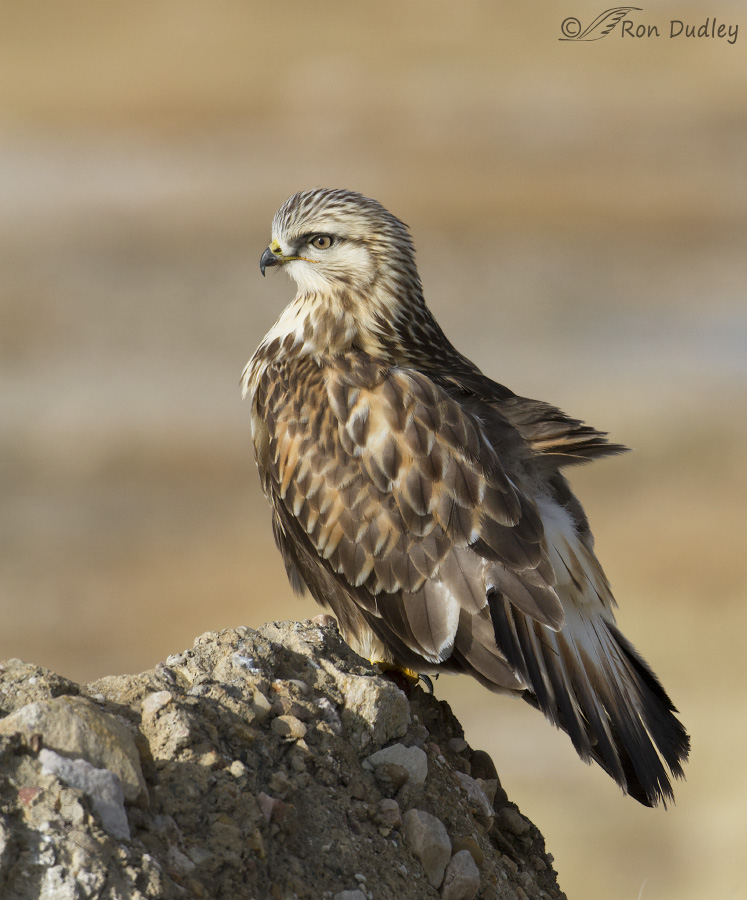
1/2000, f/8, ISO 400, Canon 7D, Canon EF 500mm f/4L IS USM, not baited, set up or called in
I spent 18 minutes with this hawk at the marina on Antelope Island back in the fall of 2011. The bird spent most of its time preening in some wonderful light so I was able to capture a wide variety of interesting poses.
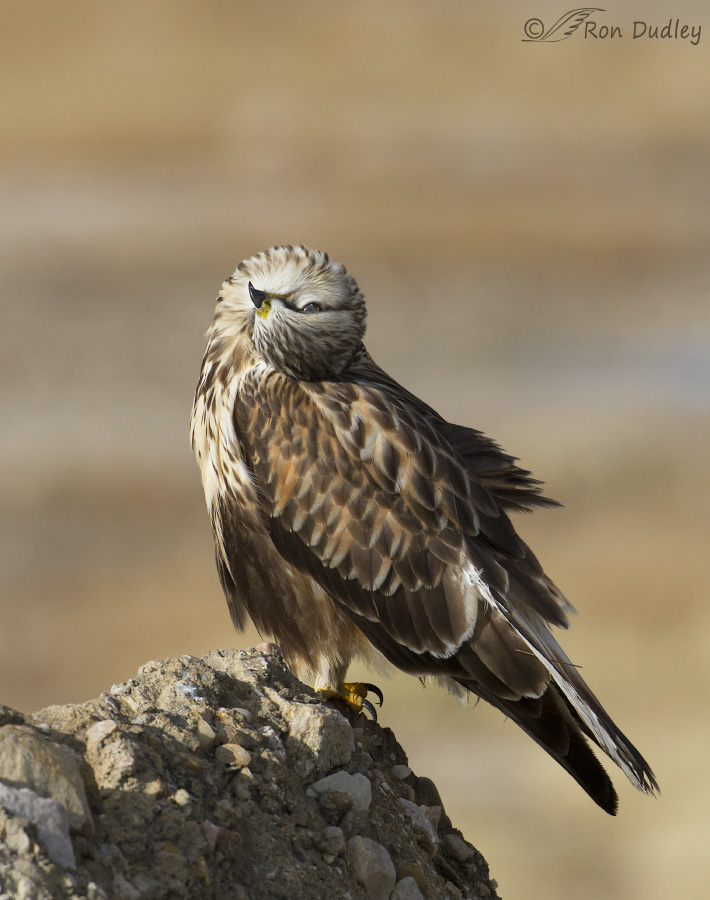
1/2500, f/8, ISO 400, Canon 7D, Canon EF 500mm f/4L IS USM, not baited, set up or called in
Many birds use this technique to groom the difficult to reach feathers on their head. There are times when I’m photographing birds that I wish my neck were this flexible. I was lucky to get any light in the eye during this maneuver, even though it appears that the nictitating membrane may be partially closed.
I have no idea where that little twig on top of the tail came from – this is the only image where I remember seeing it.
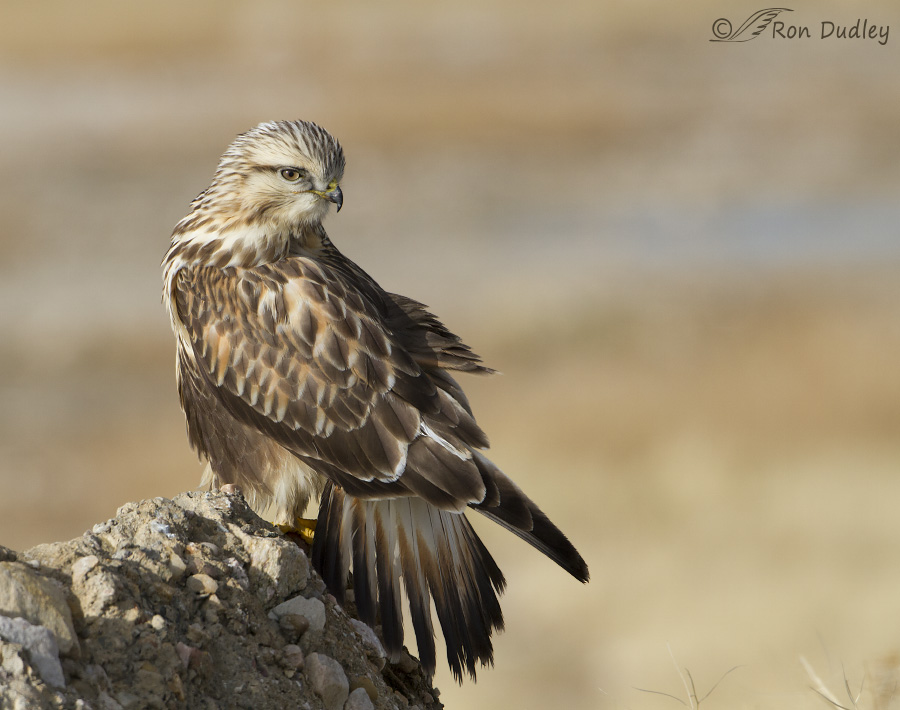
1/1600, f/8, ISO 400, Canon 7D, Canon EF 500mm f/4L IS USM, not baited, set up or called in
Many of the tail feathers were wet so the hawk often kept its tail spread to encourage drying, even when it was working over plumage in other areas.
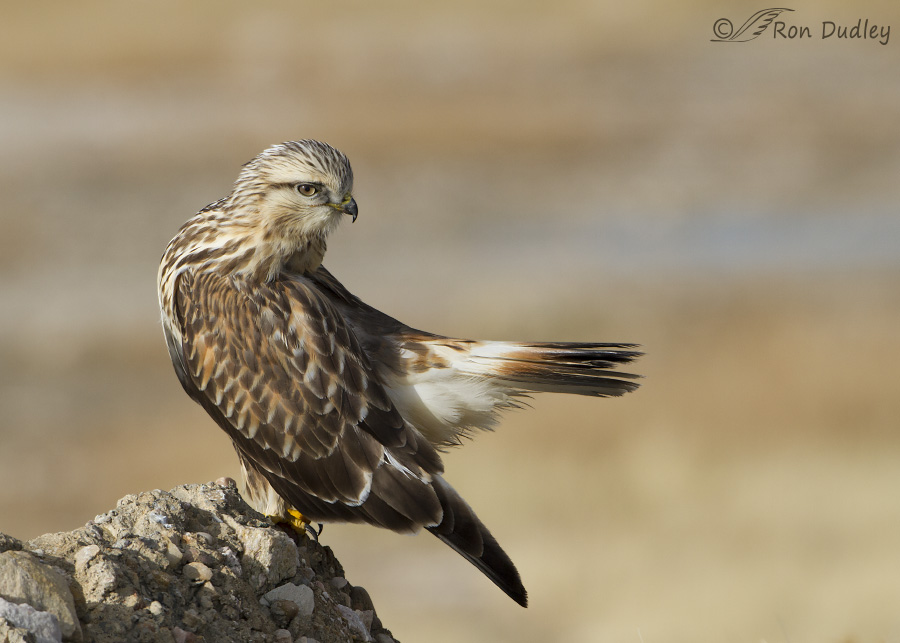
1/2000, f/8, ISO 400, Canon 7D, Canon EF 500mm f/4L IS USM, not baited, set up or called in
I like this droopy-winged posture as the bird was about to reach under its left wing.
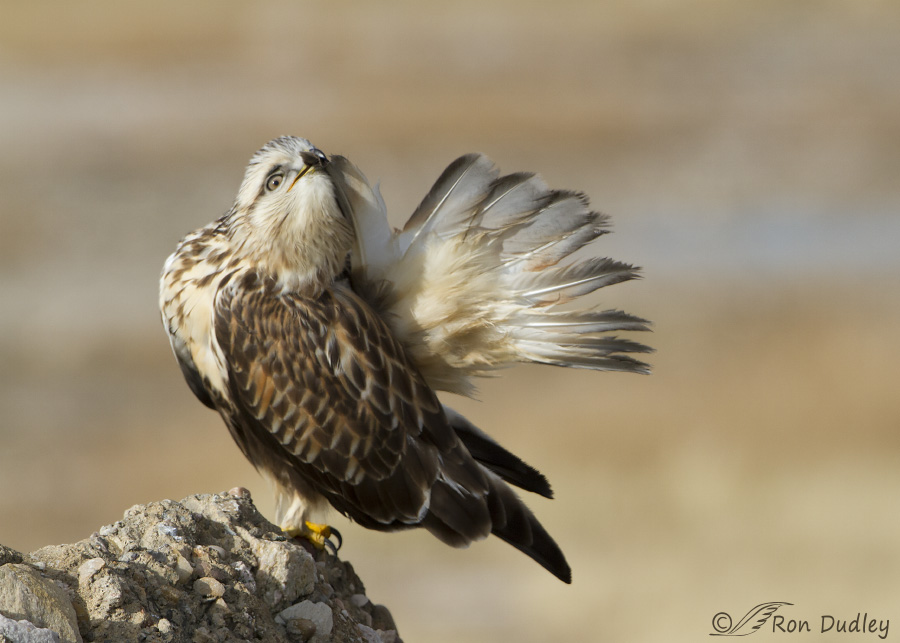
1/1600, f/8, ISO 400, Canon 7D, Canon EF 500mm f/4L IS USM, not baited, set up or called in
Here it’s “re-zipping” the hooks on the barbules of its ragged tail feathers (I’ve described the process and defined the terms involved here if you didn’t see it and have the interest). This image and the next one demonstrate well how effective the process is. Notice how ragged the feathers are on the right side of the tail as compared to the left side. That’s because the hawk has been working over the feathers on that side but hasn’t yet reached those on the right. Re-zipping those hooks makes a big difference.
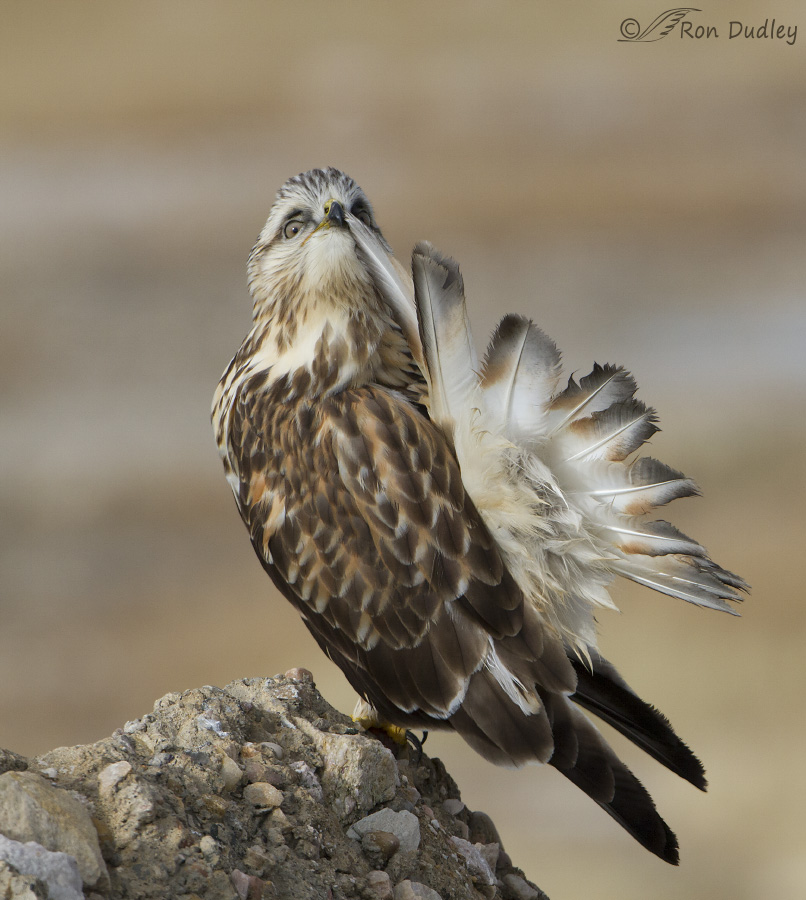
1/1600, f/8, ISO 400, Canon 7D, Canon EF 500mm f/4L IS USM, not baited, set up or called in
The bird really has to stretch when it gets to the end of one of those feathers.
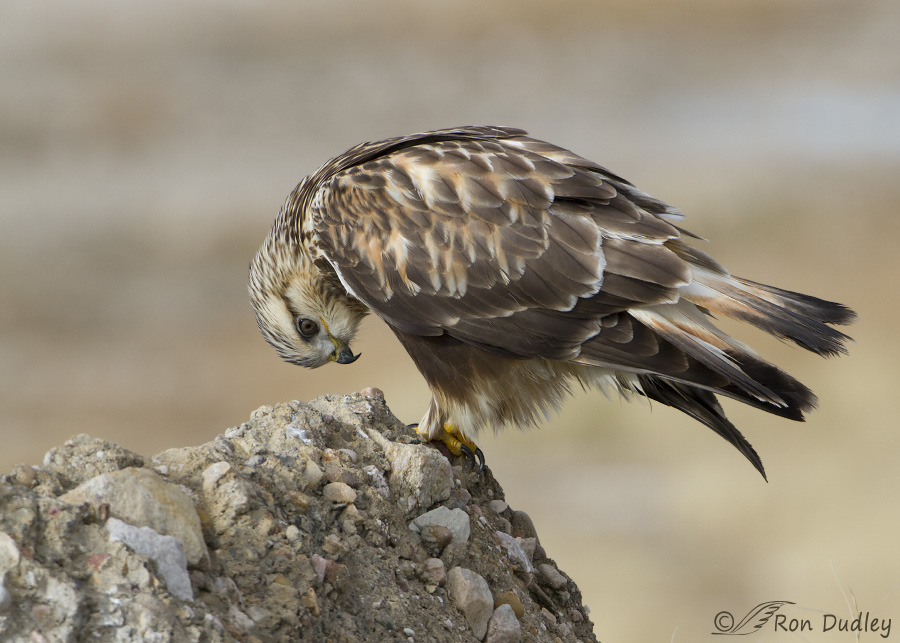
1/1000, f/8, ISO 400, Canon 7D, Canon EF 500mm f/4L IS USM, not baited, set up or called in
Here the hawk was about to work over its belly feathers.
I’ve always said that for my money the Rough-legged Hawk may be the most handsome of all North American buteos. Admittedly they have some stiff competition but I can’t think of another species that whups them in that arena.
Opinions may vary of course…
Ron


The second photo reminds me of the “outrageous contortions” of beasts in some medieval drawings. Your photo documents that some animals can get into amazing body positions from a human point of view. Maybe those medieval folks were capable of seeing things around them quite quickly.
These photos were a wonderful start to my day. Lighting is so fantastic. An amazing bird and photographer!
What an absolute, heart melting charmer.
Thank you so much. On this side of the world I am snotty, voiceless, coughing up a storm and, after seeing these photos, smiling so broadly my face hurts.
Thank you.
Dang, I hope you feel better soon, EC. I’m glad these photos cheered you up a little.
So sorry EC!! I hate it when I’m prodigiously producing snot! Hope tomorrow is better!
Thank you both. This too will pass.
Mind you, I was brought up to believe that matter can neither be created nor destroyed. If this is true I should (forgive the grossness) be a much, much smaller person given the amount of snot which has been expelled from my body.
Thank you Ron. Such a beautiful bird. Great capture!
Thanks, Jean.
He’s so handsome, and such a show off! Thank you, Kim
I think this bird knows that it’s good looking, Kim…
Beautiful bird, so many beautiful images–hard to pick a favorite, but especially like the “before and after” images of the tail preening. The difference between the “zipped” and “unzippped”, raggedy tail feathers is quite dramatic…easy to see how the unpreened ones can effect efficiency in flight….such details are so terribly important for a predator when fractions of seconds count in nabbing, or not nabbing, prey…
I’m glad you like them, Patty. Thank you.
thanks so much for this gorgeous series of shots. Love the photos and the explanations. Your site is my reward each day.I have decided I am ‘allowed’ to look after I finish a number of chores/tasks each day. The reward is ALWAYS worth it. Much appreciation
I hope you continue to enjoy my posts as much as you have in the past, Gillycat. Thank you.
I am so delighted that you posted these photos. This bird is just gorgeous. Unfortunately I’ve never had the pleasure of seeing a Roughie, but this makes me want to see one even more than before.
You were one that requested to see more of them, Susan. Thanks for the inspiration.
You see Ron, I judge who is a “pro” by the quality of their work,
and not by whether, or not they do something for a living…
In my book, the quality of work you do makes you a “pro.”
I agree, Roger!
What a BEAUTY! Just OH WOW! I just love the colors and the way they blend and play together, one morphing to the other. The lighting makes all that magic POP! And while rough-leggeds aren’t QUITE as beautiful as redtails (LOL!!), they’re just spectacular in that raptor kind of way.
I’m lucky that I get to watch bathing and preening regularly, and I always stop and just enjoy how peaceful and Zen-like the process is. I could watch for hours. It makes my life happy!
Ron, I just love it that you focus on the behavior as well as the photography. What a gift and a blessing you and your work are every morning. Thank you so MUCH!
Thanks, Laura. Lighting can make all the difference.
When I first picked up serious photography I thought many good photographers were a little anal about light quality. Boy, was I wrong!
Sometimes your images just take my breath away, and this is one of those times.
Just goes to show what a “pro” can do with “older” gear… ;-)))
Thanks, Roger. I’m no pro but I’m tenacious…
I am a new follower and have enjoyed every one of your posts, both the information and the spectacular photographs. What a marvelous series of this hawk, thank you for posting them. By the way, I can see that little stick in the very first photo- it is higher up on the tail and partly obscured by a wing. It must have shaken loose and then fallen off as the hawk preened.
Dang, you’re right, Nancy. Good eye. It’s right under the tip of one of the wing primaries.
What sensational shots Ron, thanks for sharing!
Charlotte
Thank you, Charlotte.
Wonderful wonderful images of this glorious creature, Ron … just what I needed to kick off the day today!!!!!
Thanks, Lois. May your day continue to improve!
How can you not love that head, that face – sweet!!
Yes, I know they can be fierce, focused, but your shots show the side, the view that melts a human heart!!
Great shots, thanks for sharing!
There’s just something about that rounded head and small bill (for a buteo) that appeals to me, Dick.
I have also always loved their fuzzy legs and tiny feet, WAY smaller than the feet of red-tails, say. But, whooee, very strong! When you’ve been grabbed by a roughie, you know it!
Louise, I think many of their adaptations for cold (“fuzzy legs”, small feet and overall compactness) contribute to their physical appeal for me.
LOL Louise…same thing with Ferrugs! There’s big power in those teeny, tiny feet!
Never been grabbed by a ferrug (thank heavens!) as we really don’t see them on this side of the Cascades. But our education ferrugi can land pretty darn hard on the glove! At least roughies are mostly eating small prey, the ferrug – despite their smallish feet – are going after jack rabbits and large ground squirrels.
Those 18 minutes must of been a “magical wow moment” for you Ron! IMHO perfect lighting, perfect exposure, perfect everything!
Exactly, Nancy. My time with this hawk is among the most memorable sessions I’ve ever had with a bird.
It is a beautiful bird and the light/background you captured it in really shows it off. Lot of time and energy goes into keeping those feathers in top form for sure!
Lot of time and energy goes into keeping those feathers in top form for sure! 
“Lot of time and energy goes into keeping those feathers in top form for sure!”
Judy, I liken it to the amount of time and effort (and cash) many humans put into their clothing. Some do it largely for fashion (I’m definitely not in that group) but others do it primarily to keep warm and modestly covered. Birds and humans have different reasons for “preening” but it’s incredibly important to both groups.
Fabulous set of photos. Thank you for sharing with us.
Thank you, CaJ.